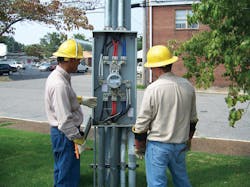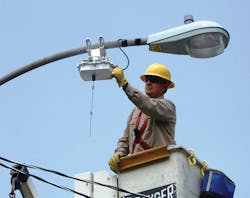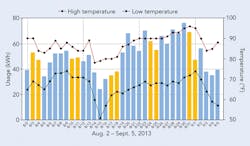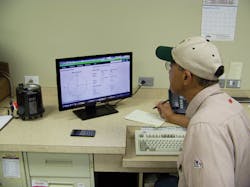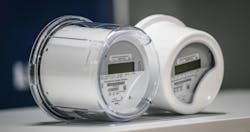When Union City Electric System made the decision to implement an advanced metering infrastructure (AMI) network, its primary motivation was to offer improved customer service and provide more payment options. However, the real value that data access and process automation would bring to its distribution system management soon became apparent.
Union City, Tennessee, U.S., is a town of 10,000 people located in the northwest corner of Tennessee, about 150 miles (241 km) north of Memphis and 5 miles (8 km) south of the Kentucky line. With five interchanges on Interstate 69 under construction within its limits, the city is poised for growth. In addition, Discovery Park of America, a regional tourism attraction funded by private funds and regional partnerships, is scheduled to open in November 2013.
The municipal utility serves about 6,300 customers, including commercial accounts such as Titan Tire, Tyson Foods and Kohler Co. As a medical center hub for the region, many commercial customers are medical related. The utility’s peak demand is about 60 MW in the summer. Because of the utility’s size — 20 employees — many of its employees perform multiple job functions.
Despite area growth, the utility was facing a rising rate of bad debts. The residential deposit of US$180 for new service had been the same for many years, and the power board was reluctant to increase it. If the deposit amount had to increase, the power board felt new customers deserved a choice. Since prepay was the only practical option, the utility began looking at advanced metering and prepay systems in 2011.
Ultimately, Union City Electric System chose vendors that had proven experience with similar utilities and had already integrated with the billing system it used. It was critical the prepay vendor had experience interfacing with both the billing system and the AMI system, and had the ability to implement time-of-use (TOU) rates in the near future.
Deploying the System
Union City Electric System also selected Landis+Gyr to provide the AMI system and Exceleron for the prepayment solution. Both systems had existing interfaces with Union City Electric System’s billing system, supplied by Central Service Association. Landis+Gyr was selected so the utility could continue to use high-current, self-contained meters in place of current transformer installations.
The Gridstream radio-frequency mesh network was an ideal selection in terms of infrastructure costs for a compact utility in a flat geographical area. However, before installing the system, there was concern improvements might be needed. The utility had installed a fiber loop around the city several years ago for substation communications and leased dark fiber to several of its customers. The fiber-optic loop turned out to be perfect for connecting with the AMI network.
The utility’s compact service territory only required one AMI data collector but two were installed to provide a fully redundant system. The collectors are connected to the utility’s office by a fiber line, and data is transferred over the Internet to secure data servers in Kansas. For several reasons, it was decided the AMI vendor would host network data at its network operations center outside of Kansas City, Kansas, U.S.
Utility employees installed the entire network infrastructure within a matter of weeks. Very few routers were needed within the mesh network, as many meters could communicate directly with the collector. The only other hardware needed was the actual meters themselves.
When it came time to install the meters, the utility had to consider several things. For instance, the utility decided to use its own employees for the change-outs, because they would be better at determining whether the meter socket needed repair. Another decision was to install meters in the fall and spring months to avoid the new meter being blamed for higher winter or summer bills.
Installing Meters
Initially, the utility planned its AMI rollout over several years. Although this seemed the best idea at first, the utility began to see the obvious benefits of the system and decided to speed up the rollout. Some resistance occurred from residential customers who had heard negative rumors about smart meters. Some customers complained about usage going up because of the meters. All these complaints were proven to be without merit and the change-out continued. By the end of the residential meter change-out, only one customer was adamant in not wanting the meter replaced. Within a month, this issue was resolved without incident and all residential customers were on the AMI system. About 40% of residential customers now have meters with integrated service disconnects. These were installed in locations of high turnover and potential prepay candidates.
Because of all the concerns and rumors on the Internet about meter accuracy, Union City Electric System tested about one in every eight residential meters installed. Of the approximately 6,000 meters installed so far, none were found to be out of the utility’s tolerance, which is even stricter than the national standard. The electronic meters used in the system proved to be much more accurate than their older electromechanical counterparts.
Early on, a communication problem was encountered because of intermittent loss of service from the local Internet provider. This created connectivity issues with the billing system in the utility office, the AMI servers in Kansas and the prepay system hosted in Texas. The decision was made to connect Union City Electric System’s fiber network to another municipal system that provides Internet service, Jackson Energy Authority, through an all-fiber connection. The systems have worked seamlessly ever since.
Realizing Benefits
Although the top priority for the technology upgrade was to provide billing options, the utility experienced unanticipated benefits that not only added efficiency but also improved the customer experience. Some of the immediate customer benefits came from access to current-usage information. The ability to show customers their daily usage matched with temperature data has helped to resolve high-bill complaints. Plus, customers can use daily usage data to reduce energy consumption. The need for data recorders installed on customer site is also eliminated.
For new accounts, the prepay option offers relief from high deposits and customers get faster service connection, sometimes even before they leave the office. Confrontations between customers and utility employees are eliminated, and customer privacy has improved because employees are not going on site to read meters or perform service disconnections. Additionally, the prepay option eliminates confrontations in the front office, as customers control their own accounts and do not pay penalties or reconnect charges.
Several efficiency improvements that help to lower costs and improve service also have occurred. In addition to reduced truck rolls and associated fuel savings, the utility already is identifying and troubleshooting outages proactively, often before the customer calls. Voltage reports help to identify high- or low-voltage situations caused by equipment issues or intermittent connection problems. Actual data is being used instead of estimates for correct equipment sizing of transformers, service, and secondary and metering installation.
Vector analysis on three-phase installations can be viewed in the office to verify proper connections and resolve possible loss of revenue issues. Loss of phase on three-phase installations is reported.
In addition to offering TOU rates, the utility also is considering integrating the AMI and supervisory control and data acquisition (SCADA) systems for projects such as conservation-voltage regulation as a way to reduce peak load and maintain power quality.
Managing the System
The utility has maintained an employee count of 20, although several jobs have changed since the process started. The utility previously used a contract meter reader who was paid by the meter. As the meter count went down, the contract meter reader was paid more per meter to try to retain his services for as long as possible. Current employees now read the remaining 300 commercial meters.
The front office staff is actively signing up customers for prepay. The utility raised the residential deposit to twice the peak monthly consumption, but all residential customers have the option to prepay. Currently, more than 400 residential customers are using the service. Many of the confrontations with customers wanting holds have been eliminated because the customer controls the account. Employees do not control cutoffs since it is a totally automated process.
The serviceman’s job is probably the one that has changed the most. Instead of making site visits to disconnect or reconnect service, as well as to get readings missed by the meter reader, he now has time to review reports and check on meters that might need a site visit. He also is able to troubleshoot any meters that may not be returning readings.
The engineering department is finding many new uses for the data now available. Initially, there were issues with access to data for some analytical programs. Data requested could be obtained directly from the hosted AMI server but was not in a format directly supported by the utility’s analysis tools. The utility was able to convert the data supplied to be used in these software applications. On a customer base of 6,300, data retention requirements are minimal. If historical data is required in the future, the AMI servers retain the data for two years.
The data hosting service option is meeting data management needs and has saved the utility from the hardware and support expense of installing servers, AMI software and a meter data management system in-house. Union City Electric System is currently retrieving a variety of data from the AMI network beyond standard billing information:
- Summation of energy by interval versus rate class. This information will ensure all customer classes are paying their fair share of costs and will allow analysis of future wholesale rate options.
- Commercial and industrial customer interval data. This will provide customer rate benefit options, including TOU or any future rates available.
- Summation of interval data by transformer. This will provide data to determine the true loading of transformers with peak loading as well as load factor information.
- Customer single interval channel data information during system peak. This will provide energy, voltage and current information per phase for proper customer equipment, transformer bank and service sizing during the utility peak. It also will give insight into the contribution of the customer’s load on utility system peak.
Learning Continues
Union City Electric is still learning new uses for its AMI data, but the initial business case is returning promised benefits already. The utility has made major strides in customer service improvements, both obvious and not so obvious to the customer. Finally, the AMI infrastructure and data hosting services have proven to be a good fit for a smaller utility that might not want to maintain or support a complex system on its own.
Jerry Bailey ([email protected]) has been with Union City Electric System for 30 years and has served as general manager for the last 19 years. He holds a BSET degree from the University of Tennessee and is a certified power executive. He is past president of the Tennessee Municipal Electric Power Association as well as the West Tennessee Industrial Association and currently serves on the regional Workforce Development Board.Companies mentioned:
Central Service Association | www.csa1.com
Exceleron Software | www.exceleron.com
Jackson Energy Authority | www.jaxenergy.com
Landis+Gyr | www.landisgyr.com
Union City Electric System| www.unioncityelectric.com

